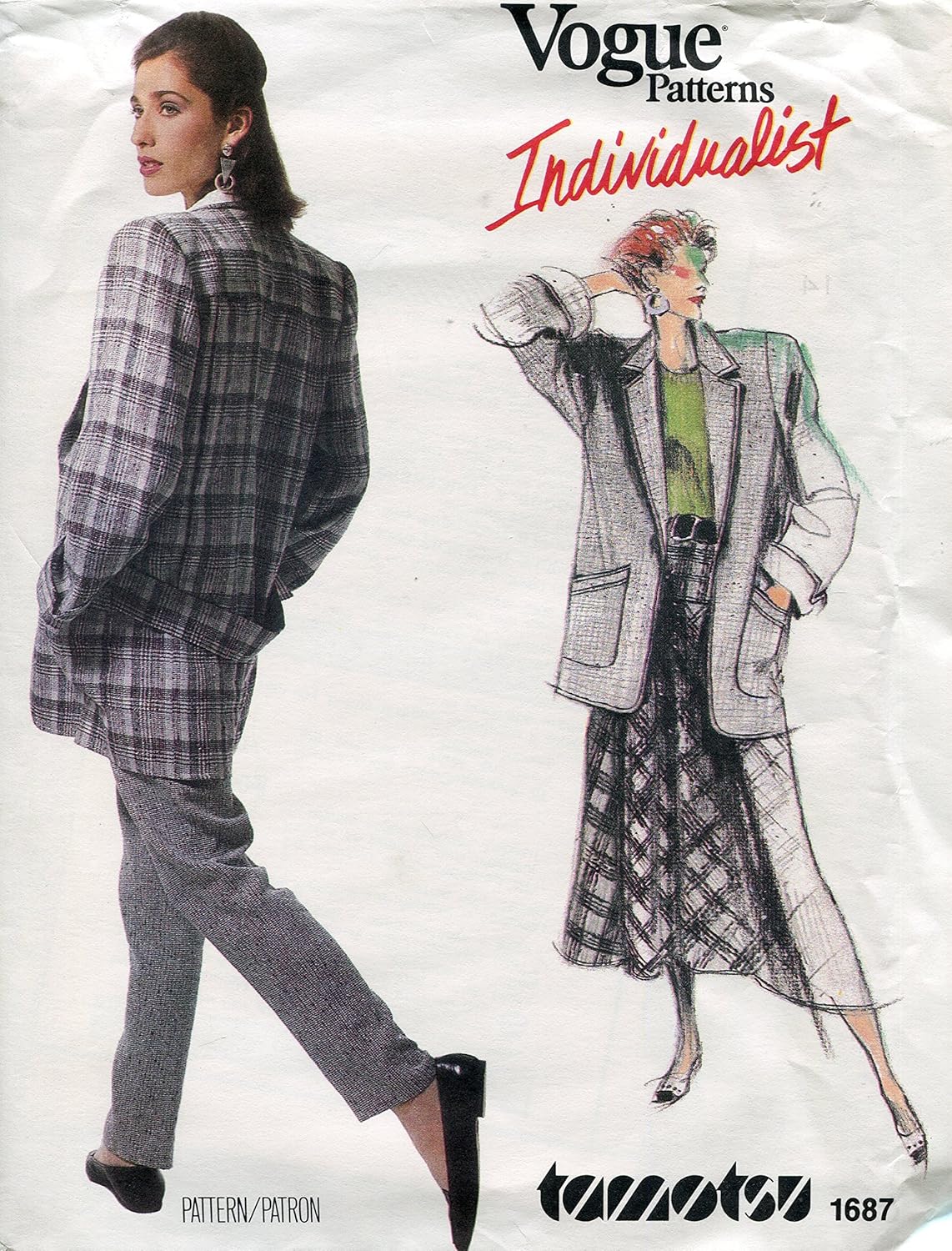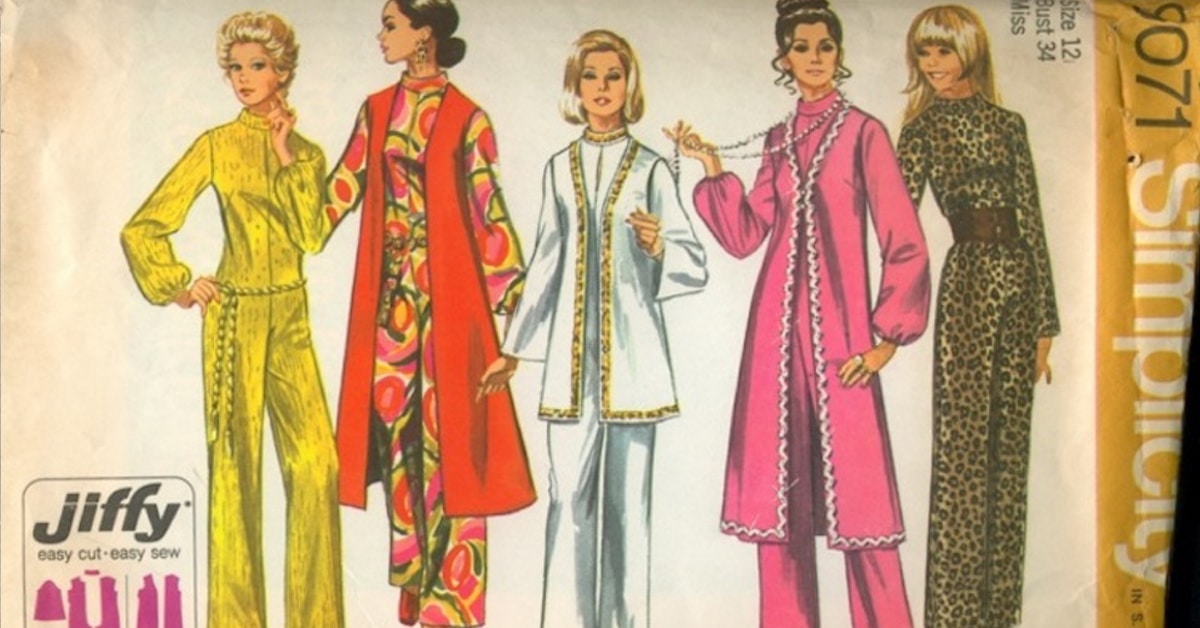 |
October 9, 2020
We had a very interesting General Q & A the last of September and it brought up some very interesting points for me. One person brought up an old (I guess vintage now), Geoffrey Beene pattern that was one of my favorites. The problem is the shoulder.
So this little pattern is very deceptive because although it looks like it would be great for folks large in the bust and shoulders.
I bought this pattern new (yeah, I'm that old!) The reason I got it was for the really neat front placket that has fitting and shaping in it. Here's a close up of the tech drawing.
You can see here, that there's a front piece that can be contrast or same color (as in the original in the photo). I did it in contrast, but along the front is a little bit of fitting. It also has a side front and a side back that is about as good as you can ever get a dolman sleeve to fit. Even with the expertise of a fabulous designer, there's still a lot of bulk in that sleeve, because of the very make-up of
it. So that sleeve needs some work - like making it a set in sleeve like this:
It may be hard to tell from this, but suddenly all that bulk under the arm is all cleaned up. In addition there's now a logical location for an FBA.
But putting in a set-in sleeve on this was more than simply cleaning up the sleeve. This was as much for style purposes as it was for cleaning-up purposes. And that's what I wanted to talk a little about.
In the 80's with the preponderance of large shoulders, the shoulders also became extended as well as higher.
So that shoulders back then were not only big, they were wide too. Designers did this because that extra oomph out made the waist and hips look even thinner and that was a huge selling point.

Everyone wanted to look thinner through the waist and hips and this was a sure way to do that. Unfortunately you ended up with some pretty unrealistic stuff.
  
And yes, I made up some of those...the last one I made in a cherry red (before I knew too much about color) and it looked horrible on me. But I was at a meeting with a good friend who had the original Tamotsu jacket only in orange (my color). I looked at her and she at me and I told her that her jacket was cool. She knew I sewed my own clothes by this time, and then I told her that her jacket was more my color and my jacket was more her
color, and that we should trade. I told her to come by and I would tweak it to fit her and she loved the idea. She felt like she got the better deal out of the whole exchange, and she probably did cause I know how well it was made, but I got the color I wanted (I couldn't find the fabric I wanted).
OK - so what's all this about? The whole reason I'm bringing this up is a lot of us pick up these vintage patterns. And it's important to know that, yes, they are constructed, drafted and tested very well. They are a blast to use. I know Vogue, and pretty sure about Butterick, would purchase the exact garment at full price, and with the permission of the designer, would take it apart and to a line-for-line copy of the
pattern pieces. That kind of quality is hard to find today unless you get into some independent pattern companies and old standards like BurdaStyle.
The thing to be aware of here is the style in which the garment was designed. Then taking into consideration our view on the current "in" silhouette. Here's some examples of what I mean.

So this looks like a fun sort of semi-flattering look. The problem here is that this is bottom heavy. That is something that is not in today's silhouette. Today's silhouette is more up and down and more emphasis on the waist - just above the waist. This accentuates below the waist and then extra fullness at the hip.
How to fix this? Less fullness at the hip, which means more pie pieces on the side (thin or less fabric at the top and full at the bottom). The main thing would be to raise the waist. Keeping the same waistline, simply raising it about 2" or more, and this becomes a very chic look!

So this looks very chic and it is, but it's too straight-up-and-down. It needs more line definition to it to be a fresher look. How to fix it? There are several options here, but the most obvious is to make the skirt a little fuller, either with the addition of godets or in the seam at the bottom needs to be fuller. This also has some great dart-fitting seams, and those can be more
fitted. I actually like the way this fit through the bust and upper waist. At the above-waist height, it should flare a little stronger, not a lot but a little stronger to make a little fuller skirt. This would be closer to what we would do today with a silhouette.

Actually this is a pretty cool pattern. But there are still some problems. First of all, in case you don't know this jumpsuits, or anything close to them are never comfy EVER! There is never enough way to put in enough ease to this garment to be comfy. So don't make it! It's not cool. It's not
comfortable ever!!!
Now, that we have that solved, the tunic isn't bad, but the pants are too big to make the tunic work. The pants would have to be "slim" (very slim) to work. But the tunic isn't bad. The puffy-cuff sleeves aren't good (but you already knew that). A better length would be 3/4 sleeve length - keep the tunic as is, and wear it with leggings.

The silhouette that seems to be emerging right now is the higher waist, fuller skirt (unless you're a Rectangle or Apple, then keep it tapered, but still fuller at the hem - like an A-line skirt), shoulders can be a little broader-a tad higher, bust is fitted (not skin-tight) and only to just below the apex point, a smoother line from the waist to the him (part of the benefit of a higher waist) and to the knee or mid-thigh with leggings. This sort
of silhouette is what we are used to seeing.
Doing the monthly General Q & A is one of the fun things I do every month. It is for anyone who's purchased out of the Resource Library, you get 2 months free General Q & A. You can bring any question(s) you like to the live video (or can ask ahead of time if you can't attend the live video) and if the answer is too long - then I simply record it in the Resource Doc
for the Q & A and it's available later. But we have a lot of fun in these videos, and I love it when participants stand up show me where the fitting problem or construction problem is, and I can say, do this or that or more here or like that and even set up my phone so that I can do remotes on the machine or cutting/drafting table.
If you've purchased something in the last 2 months, you should have received an email with a link to the resource document. If you've purchased something in the last 2 months and HAVE NOT received an email, please PLEASE, LMK!!!
 September's Feature Resource
September's Feature Resource
Fitting With Proportion and Figure Flattering Tools
aka Apex and Proportion Tools
This is one of my best resources in the library as it collects the 40 years of experience I have i fitting all sizes, shapes and styles. And I mean all of them. A dwarf who was a bridesmaid - the bride brought me the fabric and trim and a photo of what the other girls were wearing - and she wanted something that would really last and it did! Another debutante had scoliosis surgery (to correct her spinal curvature which would have eventually pressed against her
lungs and kill her) 3 months before the ball and I designed her dream dress to wear on her special night. Then countless grandmothers and mothers who watched their granddaughters and daughters be fitted by me and wanted the same treatment. Their bodies weren't so complicated as much as having 30 to 60 years of living in them and like all of us wanted to look special.
 
This is my scoliosis deb and her beautiful smile!
You sorta feel sorry for those who can't sew - And no, you don't sew for others, unless it's for someone really special!
The Fitting With Proportion and Figure Flattering Tools Resource is available here and is at a 16% off. I rounded the cents down so it's a little more discount this month.
PS - I do a lot of posting on Facebook as SewingArtistry - like my page to see more goodies!
To view this email in browser or to see past emails click here. (This works now and is a lot of fun to check out!)
We respect your email privacy
|
|
|
|